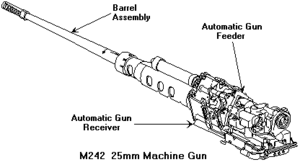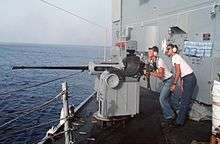Chain gun
A chain gun is a type of machine gun or autocannon that uses an external source of power to cycle the weapon rather than diverting energy from the cartridge, and does so via a continuous loop of chain similar to that used on a motorcycle or bicycle.[1][2]

Development history
In 1972, Hughes Helicopters began a company-funded research effort to design a single machine gun to fire the U.S. Army's M50 20 mm round.[1][2] By April 1973, the program had fired test rounds in more powerful 30 mm WECOM linked ammunition, from a prototype (A model). In January 1975 a model "C" was added, a linkless version for the proposed Advanced Attack Helicopter YAH-64; the helicopter was later adopted as the Hughes Model 77/AH-64A Apache, with the model C (receiving the designation M230 chain gun) as standard armament.[1][2]
In 1976, Hughes Helicopters successfully patented the chain gun[3] and it has since been further developed into several other system of different caliber sizes.[1][2]
As of 2019, "Chain gun" is a registered trademark of Northrop Grumman Innovation Systems (formerly Orbital ATK, following several mergers and outright acquisitions after Hughes Helicopters) for "externally-powered machine guns".[3]
Description
Reliability and controllability are the advantages of chain-driven weapons over their recoil-actuated counterparts. Recoil-actuated firearms depend upon the sometimes unreliable firing of a cartridge to power the cycle of action, whereas a chain gun uses an electric motor to drive a chain which moves in a rectangular circuit via four sprockets that apply tension to it. One link of the chain is connected to the bolt assembly, moving it back and forth to load, fire, extract, and eject cartridges.
A misfired round does not stop the functioning of the weapon, as it might with guns that use energy from a fired cartridge to load the next round; it is simply ejected.
During each full cycle of four periods, two periods (passage along the "long" sides of the rectangle) control the time that the bolt takes to drive forward and load a round into the chamber, and how quickly it extracts it. The other two periods, when the chain moves across the "short" sides of the rectangle, sideways relative to the axis of the barrel, determine how long the breech remains locked while firing, and open to allow cartridge extraction and ventilation of fumes.
The time that the chain takes to move around a complete loop of the rectangle controls the rate of fire, so varying the motor speed allows chain guns, in principle, to fire at a rate continuously variable from single rounds to the maximum safe rate imposed by the pressure drop rates in the barrel after firing a cartridge, mechanical tolerances, and other factors. For example, the 7.62mm NATO version EX-34 was advertised to offer 570 rounds per minute, and developmental work was underway for a 1,000-rounds-per-minute version. In practice, chain guns usually have two or three set firing speeds.
The chain gun operating principle is inherently reliable. An unclassified report on the EX-34 prepared by the Naval Surface Weapons Center in Dahlgren, Virginia, dated September 23, 1983, said that:
29,721 rounds of endurance tests were fired with no parts breakage and without any gun stoppages ... It is significant that during firing of 101,343 rounds not one jam or stoppage occurred due to loss of round control in the gun or feeder mechanism ... [this] is in our experience very unusual in any weapon of any caliber or type.
A chain gun has a single barrel, whereas a Gatling gun and a Minigun have multiple rotating barrels with no internal chains to drive the weapon.
List of Chain Guns

| Chain Gun | Calibre | Uses |
|---|---|---|
| L94A1 | 7.62 x 51mm | AFVs such as Challenger 2 and FV510 Warrior (coaxial gun) |
| M242 Bushmaster | 25 x 137 mm | AFVs such as the M2 Bradley and LAV-25, Mk 38 mount on warships |
| M230 | 30 x 113 mm | AH-64 Apache |
| Mk44 Bushmaster II | 30 x 173 mm | AFVs such as CV90, as the DS30M and Mk 46 mounts on warships |
| Bushmaster III | 35 x 228 mm | AFVs such as CV90 |
| Bushmaster II | 40 x 180mm | |
| Bushmaster III | 50 x 319 mm |
References
- Richardson & Peacock, 1992, pp. 38–40.
- Chinn, George M., 1987, pp. 453–454.
- "Trademark Assignment Abstract of Title". United States Patent and Trademark Office. 12 November 2018. Retrieved 28 April 2019.
Bibliography
- Chinn, George M. (Lt.Col., USMC, Retd), ed. (1987). The Machine Gun: History, Evolution, and Development of Manual, Automatic, and Airborne Repeating Weapons (PDF). Vol. V. Ann Arbor, Michigan: Edward Brothers Publishing Co. Retrieved 19 March 2019.
- Richardson, Doug & Peacock, Lindsay (1992). Combat Aircraft: AH-64 Apache. London: Salamander Books. ISBN 0-86101-675-0.
- U.S. Army Field Manual 3-22.1